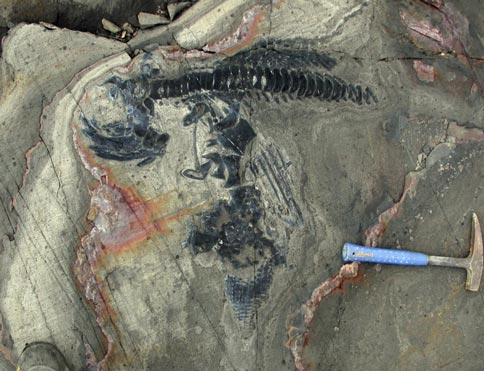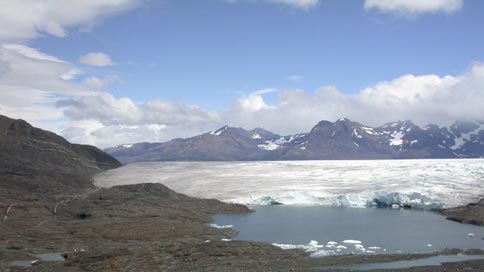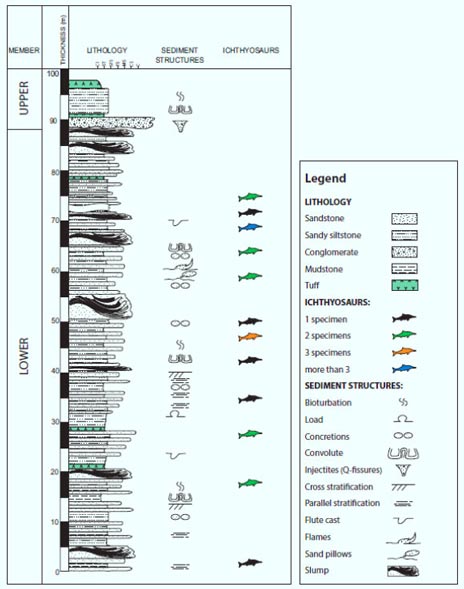Forty-Six Ichthyosaur Fossils Discovered in Chile
Retreating Glacier Reveals Ichthyosaur Graveyard
A team of German and Chilean researchers have just about finished cataloguing, mapping and recording one of the densest assemblies of ichthyosaur fossils ever found. Scientists from Heidelberg University and the State Museum of Natural History, Karlsruhe, in collaboration with colleagues from a number of scientific institutions in Chile, have identified a total of forty-six, complete or near complete specimens of Early Cretaceous ichthyosaurs (fish-lizards). The fossils represent at least four species, with juveniles, pregnant females and other adult ichthyosaurs having been identified.
Ichthyosaur Fossils
All the ichthyosaur fossils represent ophthalmosaurids and the site is being heralded as the most important location discovered to date in South America that records a marine ecosystem that existed around 140 to 132 million years ago.
One of the Many Ichthyosaur Fossils Found at the Site
Picture credit: W. Stinnesbeck
In the picture above, the geological hammer provides scale and to the left of the picture elements of a limb and the small pebble-like bones that make up a flipper can clearly be seen. The back-bones and ribs can also be made out. The ichthyosaur specimen has been identified as Platypterygius hauthali.
Discovered as Glacier Retreated
The fossils were found as a glacier retreated in the Torres del Paine National Park, southern Chile. The retreat of the glacier (Tyndall glacier) revealing the fossils could be a case of global warming providing palaeontologists with benefits, affording them a unique insight into an ancient marine ecosystem. Some of the ichthyosaurs are so well preserved that skin tissue imprints have been found, along with the remains of embryos within the body cavity of female ichthyosaurs. Such is the concentration of “fish lizard” remains, that the Tyndall glacier location has been heralded as amongst the prime fossil Lagerstätten for Early Cretaceous marine reptiles worldwide.
The Remote and Beautiful Tyndall Glacier (southern Chile)
Picture credit: W. Stinnesbeck
Fast-swimming, Predatory Marine Reptiles
Ichthyosaurs were an Order of fast-swimming, nektonic and predatory marine reptiles with dolphin-shaped bodies. They evolved in the Early Triassic and survived into the Late Cretaceous, eventually dying out as a group around eighty million years ago. It is now thought ophthalmosaurid ichthyosaurs like most other ichthyosaurs, were viviparous, that is, the females retained fertilised eggs inside their body, until the embryos were sufficiently well developed to be born directly into the sea.
A Model of a Typical Ichthyosaur
Picture credit: Safari Ltd
The first fossils were discovered in 2004 as scientists were mapping the retreat of the glacier. It has taken a total of three major field expeditions for all the ichthyosaur material exposed at the site to be mapped and catalogued. An academic paper detailing the research has been published in the scientific journal “The Bulletin of the Geological Society of America”.
Alongside, the remains of the reptiles, the research team found ammonites, belemnites, bivalves and marine fish fossils. In addition, there were plant fossils also preserved. The ichthyosaurs were not found at the same level in the strata, but scattered throughout the Formation Member at several levels indicating mass mortality events occurring in this marine ecosystem from time to time.
A Diagram Representing the Deposition of the Strata and Indicating the Location of Ichthyosaur Fossils
Picture credit: W. Stinnesbeck
Interpreting the Geology
The joint German and Chilean research team have interpreted the geology of this location thus:
The gregarious ichthyosaurs lived and hunted along the north-eastern edge of a deep sea that then separated the Antarctic continent from the southern tip of South America. Cold water rising up from the depths of a deep underwater canyon provided nutrients to sustain a large population of primary producers such as plankton. These were fed upon by large shoals of bony fish and belemnites. The ichthyosaurs in turn hunted the fish and the cephalopods.
With the rifting of the sea floor as geological forces gradually extended the Atlantic Ocean, there were a great number of earthquakes. Some of these earthquakes were powerful enough to set off underwater avalanches that swept marine organisms down the steep slopes into the deeper water. This led to the formation of several “ichthyosaur graveyards”.
Commenting on the significance of this discovery, one of the lead authors of the research paper, Professor Dr Wolfgang Stinnesbeck, Institute of Earth Sciences (Heidelberg University) stated:
“Occasionally, high energy turbiditic mudflows sucked down everything in their reach, including ichthyosaurs. Inside the suspension flows, the air-breathing reptiles lost orientation and finally drowned. They were instantly buried in the abyss at the bottom of the canyon.”
The speed of burial and the lack of oxygen in the mud layers permitted the exceptional degree of preservation.
The professor went added:
“The deposit is Early Cretaceous in age [Valanginian to Hauterivian faunal stage] and forms part of a deep water sequence located in the Rocas Verdes Basin, a straight separating Antarctica and South America from Late Jurassic to Early Cretaceous times.





